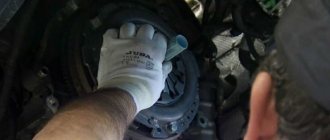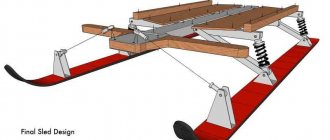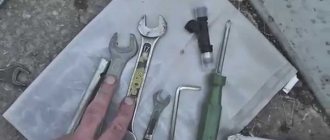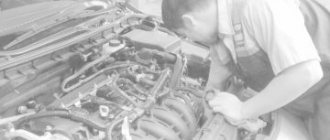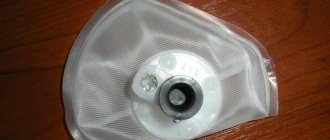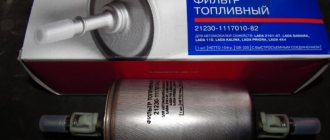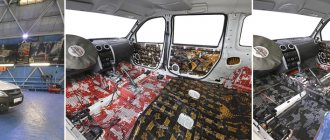Let's start replacing
The video shows how to change the front suspension silent blocks:
So, if you are determined to replace the silent blocks yourself, then in addition to the standard set of tools you also need to take a vice, a medium-sized sledgehammer, and extended bolts. Before you begin the process, decide which node you want to start with and see which elements have failed.
Also, let's immediately find out what not to do when replacing the silent blocks of the lever:
- Do not lubricate new silent blocks with engine oil. Remember that they are made of rubber, which quickly breaks down after contact with oil.
- Don't replace just one worn item. Replace all such parts on the axle at once.
- Do not burn the rubber with a soldering iron to remove the silent block. You won't achieve anything by doing this, you'll just inhale smoke.
- Do not remove multiple rods at the same time. This can make it very difficult to install them back.
Replacing the rear silent blocks includes installing the rear suspension arm and ball joint. To do this you will need a hydraulic press and a mandrel. However, if you take a risk, you can do without them.
First you need to remove the part. To do this, pull or clamp the rod in a vice. Take a long drill bit and drill holes in the rubber in a circle. The distance between holes should be minimal. Now you can easily pull out the inner bushing of the silent block. Try to make sure that only the outer ring remains.
In the video, the rear wishbone silent blocks are being replaced:
Now insert the hacksaw blade and make two cuts along the entire length of the remaining clip
Be careful not to cut through the rod. Use a chisel to hook the edge of the cut section and bend it inward using a hammer
Do the same on the other edge of the part. Remember, every blow of the hammer brings you closer to victory. At one point, the silent block clip will begin to creep down and you can easily knock it out.
You will also need time to return the silent block to its place. To do this, take two good metal pancakes that have a hole inside. The inner bushing of the silent block should easily fit into it.
Now place the rod on the floor, install the element, cover it with a pancake and hit this structure with a pancake. With a strong and accurate blow, it will partially go in. Be careful as it may bounce or become askew.
The video shows the installation of a polyurethane silent block:
If you managed to drive the silent block the first time, now you can put more force into the blow. Don't forget to put a second metal block under the rod, otherwise the bushing will rest against the floor. Now a couple more blows and the installation is complete, you can proceed to the next unit.
Replacing the front silent blocks is practically no different.
It is important to adjust the wheel alignment after the work has been completed. As you can see, to replace silent blocks you will need to put in a lot of physical effort and spend at least a day in the garage
Be attentive to the described nuances of this technological process, so as not to contact a service station later. If you are careful, persistent and patient, you will have new silent blocks, which means silent trips and serviceable car components
As you can see, to replace silent blocks you will need to put in a lot of physical effort and spend at least a day in the garage. Be attentive to the described nuances of this technological process, so as not to contact a service station later. If you are careful, persistent and patient, you will have new silent blocks, which means silent trips and serviceable car components.
Dismantling and installation process
Installation begins after purchasing the parts. You will need a tool - wrenches for removing the beam and suspension arms, a hammer or sledgehammer.
Step by step guide:
- The car is driven into a pit or overpass. You can lift the wheel with a jack, but it is so inconvenient to work with the suspension - you have to work lying down. The jack foot should not be in the same plane as the beam bracket.
- Dismantle the suspension beam. Be sure to remove the handbrake cable when doing this.
- The brackets have special brackets that hold the brake system hoses. The staples are removed.
- The old silent block of the beam is dismantled. Garage conditions require the use of a hammer or sledgehammer. You should work carefully so as not to damage the seat, otherwise there will be problems with installing the new part.
- The seat is cleaned of dirt and graphite lubricant is placed there.
- Install a new part. Replacement of the silent block of the rear beam is done so that there are no gaps or holes. Pressing is done with careful blows of a hammer.
- Reassemble the beam in the reverse order.
The replacement is complete and you can drive the car immediately. During assembly, you should check the installation of each part and only then proceed with assembling the next one. The silent block of the front beam is changed according to the same scheme.
Dismantling the old gum is done with 3 - 4 strong blows with a sledgehammer. You should hit strictly in the center of the part, without deviating to the side from the vertical axis. The edge of the clip is bent using a chisel to facilitate dismantling.
We recommend: Review of suitable sealants for the engine cooling system
Experienced craftsmen use a piece of tube to press out the silent block of the rear beam. It is important that its diameter is slightly smaller than the same parameter of the seat. The tube is placed against the part and hit with a hammer. In a few blows the part will be removed without unnecessary operations.
Having removed the silent block of the rear beam, check the seat. There should be no chips or cracks on it. If there are any, the part should be replaced. Otherwise, the new silent block will not fit as it should.
What are silent blocks
Silent block is a part that dampens vibrations that occur between the suspension elements during movement. Thus, it dampens noise and vibrations that can lead to rapid wear of parts. The hinge is very important because it is responsible for the correct operation of the entire system. It consists of inner and outer metal bushings, with a rubber or polyurethane gasket placed between them.
Note that polyurethane silent blocks are considered more durable and last up to 2-3 times longer than rubber ones. Cars equipped with polyurethane hinges listen better to the driver.
It is important to monitor the serviceability of silent blocks, because their breakdown leads to difficulties in controlling the car, slowing down the reaction - the car will not immediately respond to the driver’s actions. In extreme cases, the car will wobble from side to side at speed.
Recommendations for choosing silent blocks
In order for new silent blocks to last long enough, you need to choose them correctly. The modern automotive market offers a wide selection of these parts, differing in material, manufacturer and, accordingly, cost. Speaking of material. For the production of silent blocks, rubber (caoutchouc) or polyurethane is used.
How to choose a front arm silent block
Rubber products are considered cheaper, but they last several times less. Vibration isolators made of polyurethane, in addition to their long service life, do not come out of the grooves of their seat under mechanical stress. Therefore, after installing such products, you can forget about repairs for a long time.
Main types of silent blocks
Important! For cars with low operating conditions, rubber silent blocks are suitable, but if the car is driven daily, then it is better to install polyurethane products.
Regardless of the material used, it is important to choose the right manufacturer. The main thing here is not to save money, because the cheapest parts will quickly wear out, which is fraught with serious consequences. Immediately before purchasing a silent block, you need to clarify whether it is suitable specifically for the levers of your car model.
Which silent blocks are better, rubber or polyurethane?
Lessons from Audi
The Audi TT is one of the best small sports coupes in the world today.
There were no signs of trouble with the Audi TT sports coupe. The company is serious, the car passed all possible tests, was sent to people, but a few months after the start of sales, information began to appear about increasing cases of accidents involving TTs associated with a sudden loss of controllability at high speeds
With a sharp release of gas, in long turns, with any careless movement of the steering wheel, the TT completely lost the connection of the rear axle with the road. The number of accidents acquired catastrophic proportions, which forced engineers from Ingolstadt to conduct repeated, more detailed studies
It turned out that at speeds above 200 km/h, despite the intelligent control system for aerodynamic elements, the grip of the rear wheels with the road was almost completely lost, and when braking this was felt even more clearly. The company put their heads together, but the car was already firmly on the assembly line, so the solution had to be instant and effective. It was found. If we list the changes that Audi has made to the TT's design, it will seem like a joke to many, but the car's handling has stabilized, and the TT is one of the best small sports coupes in the world today. Here's what has changed.
The front stabilizer has become a millimeter thicker, the rear stabilizer has become a millimeter thinner, and most importantly, the geometry of the front arm has been microscopically changed and the diameter of the lower silent block has been increased, therefore, it has become a little softer. That's all that has been changed, but the car has excellent handling and stable, predictable behavior at any speed. Therefore, any change in the characteristics of the silent block can greatly affect the vehicle’s handling and, as a result, traffic safety.
What's happened
The silent block is a rubber-metal bushing, which is designed to connect two parts. An internal polyurethane insert connects two separate metal bushings and the whole thing is inserted into a metal cage.
This part dampens or reduces the force of impacts coming from the wheels onto car parts, thereby protecting them from premature failure. You can imagine the force of impact on the block when driving on uneven road surfaces. The silent block (“quiet block”) is used in the rear and front suspension, for mounting the engine, gearbox and other parts of the car.
Thus, it becomes clear that the “quiet unit” is very important for the car and its timely replacement will avoid more expensive repairs.
Why do you need a suspension arm silent block?
A rubber-metal hinge or silent block is a part consisting of two metal tubes, between which there is a polyurethane or bushing, which is why it is called a polyurethane silent block. The decoding of the name itself will help explain its purpose. “Silent” is translated from English as “quiet”, therefore the part is used in the mechanism to suppress vibration and noise. A silent block is used to connect the suspension parts, and a rubber insert helps soften impacts on its components. They secure the anti-roll bars and control arms.
The silent block is also used to connect the rear suspension. And also for attaching shock absorbers, gearbox or engine. This part can withstand enormous loads, so it quickly fails and requires frequent replacement. The performance of the silent block is affected by the condition of the road surface, sudden temperature changes, and the service life of the vehicle itself. In some cases, rubber begins to crack due to age.
Typically, the manufacturer of the part guarantees that it can withstand a mileage of one hundred thousand kilometers. But given the state of the roads in our country, it’s better not to risk it. Every car enthusiast should carry out a visual inspection of the silent block after 50,000 km. It is very easy to do this even at home.
Silent block design and materials
The silent block is designed very simply. An outer bushing that is pressed into the suspension arm, an inner bushing that is bolted to the front beam or subframe, and they are held together by special rubber or polyurethane. The main task of the part is to provide a movable connection and dampen vibrations in the suspension, as well as adjust the angles of rotation of the front arm under high loads. For almost every car today you can buy both a rubber silent block and a polyurethane one. There is a difference, and not only the price of parts can affect the choice. It makes sense to take a closer look at both bushings so that replacing the silent blocks of the front levers can be done with great effect.
The silent block provides a movable connection and dampens vibrations in the suspension
Polyurethane appeared in modern cars not so long ago, and it was used mainly on sports cars. A little later, the counters began to be full of multi-colored polyurethane silent blocks, but compared to rubber ones, their price was almost three times higher. The calculation was, of course, not for the owners of the VAZ 2109 or 2110. At that time, they were quite satisfied with ordinary bushings made of oil- and petrol-resistant rubber. But owners of used Renault, Mitsubishi Pajero or Nissan Patrol will think twice before ordering a branded silent block for a fairly substantial amount, so polyurethane parts have begun to be popular with them.
Replacing silent blocks on the “nine” and “ten”
So, if you decide to change the silent blocks on your car yourself, how to do it? Let's take popular cars as an example: VAZ 2109, 2110 and 2107. Let's assume you need to replace the silent blocks of the rear beam of a VAZ 2109. In this case, the procedure is as follows:
- we prepare tools and consumables - wrenches for wheel bolts, spanners for 19. Hammer, crowbar, a wooden block the size of a brick, a puller for hinges, a jack and new bushings for replacement;
- jack up the rear of the car and remove the wheel;
- to make your work easier, it is advisable to treat all bolts and fasteners with WD40;
- disconnect the brake lines and unscrew the nut that holds the bolt connecting the rear beam with the mount on the body itself;
- we take out the bolt and, using a crowbar, carefully move the rear beam down so that a wooden block fits between it and the body;
- Now the hardest part is that you need to knock out the old silent block. This can be done using a special device or a hammer. As a last resort, drill out the old rubber and pull out the bushing scraps;
- clean the hole and lubricate it with soapy water to make the new bushing easier to fit into place;
- installing a new bushing is also not an easy task - for this they use a special device or a structure consisting of a bolt, nut and two large washers. A long bolt is threaded into the bushing and eye of the beam, and the nut is slowly screwed in so that the part snaps into place;
- When everything is ready, we install the beam in place in the reverse order.
Note that replacing the silent blocks of the rear beam of a VAZ 2110 is carried out in a similar way, so we will not describe it in detail. But we’ll talk about the “seven” separately, using its example to show how to replace the bushings on the front suspension.
Regulations for replacing silent blocks
On modern passenger cars VAZ Niva, Hyundai Accent, Chevrolet Aveo, Cruz, Dacia Logan, Daewoo Lanos and similar budget cars, the recommended schedule for replacing the silent block revolves around the figure of 100 thousand. There is no certainty on this issue, since polyurethane from a good company can cost at least 350 thousand, and an average lousy rubber silent block can crumble after 60 thousand, so you should always listen to their behavior, especially when the car was recently purchased or someone else’s.
In modern cars, the silent block needs to be changed once every 100 thousand km
The condition of the silent block can be assessed both visually and by the gaps or lack thereof. For a visual assessment, it is enough to inspect the levers, and if there are no delaminations, swelling, or chipping on the surface of the silent blocks, it is still normal. Knocking and play in the front suspension will also tell a lot. If replacement is still necessary, then it is quite possible to do it yourself, without involving service specialists. This will require mostly persistence and a philosophical approach.
